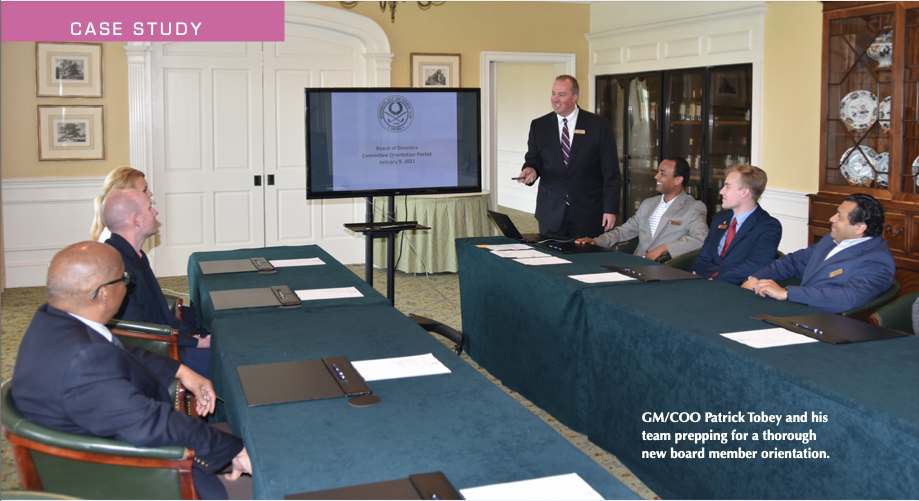Getting Everyone Up to Speed in Their Lanes

Before becoming the general manager/COO of the ninth oldest golf club in the country, Patrick Tobey, CCM, CCE, CEC, held positions at both resorts and private clubs as a chef and assistant general manager. Some great mentors along the way and exposure to management/governance models that varied in both structure and effectiveness, coupled with his proclivity for transparent communications and an approachable leadership style, primed Tobey for the current success he enjoys at Washington Golf and Country Club (WGCC) in Arlington, Va.
When he joined WGCC 13 years ago—his first GM/COO position—there was no board orientation program in place. Tobey believed that, to set the foundation for his success in the position, he needed to institute an immersive club orientation for new board members where he could communicate vital information and explicitly state roles, responsibilities and boundaries. It has evolved into an annual day-long meeting that sets the tone for new board members as well as returning board members who, often, attend throughout their terms.
Getting into the Game
WGCC’s governance structure is not unique: The 12 members of the board are elected to serve three-year terms and each chairs one of the club’s committees, which are responsible for bringing recommendations to the board for consideration. The president presides as chair and Tobey is responsible for getting the action items successfully executed from an operational standpoint. But one of the things that sets the club apart is its immersive and thorough board orientation that has transformed the volunteer leadership’s perspective on WGCC’s management and keeps them focused on their primary duty: to ensure proper governance in accordance with the articles of incorporation, bylaws, and rules and customs.
Tobey designed the orientation after seeking out resources from the National Club Association (NCA) and other industry partners and asked other club managers to share guidance from their own orientation programs. Each year in early January, new board members are required to attend a half-day orientation that is refined annually and is integral to a seamless board tenure and a very positive leadership culture.
“We started the orientation to get board members off the sidelines and into the game … to be an active part of the governance by immersing them into the culture of the rich history of the club. We started with defining roles and responsibilities, but we also inspire in them the desire to be the lead cheerleaders on the way the club runs best,” Tobey said.
Tobey has a quick witted, open-book demeanor and is seen around the club daily engaging in friendly banter and light-hearted repartee with members; however, he’s found that for his orientations, it pays to have everything scripted, timed out, and rehearsed to maximize the time and have the greatest impact. Each board member gets an iPad, and the agenda and other materials are available in advance through the club’s BoardEffect portal, an online tool Tobey uses to manage the board books and upload relevant documents, such as rosters, calendars, governance manual and minutes of previous meetings.
Knowing Their Lanes
While he jokes that it is the “Patrick Tobey Show,” it is an opportune time to share more about his background and credentials and communicate his management style as well as effectively convey two themes:
1. Throughout the day, he illustrates for the board how each of the agenda items support WGCC’s Five Pillars: Staff, Facilities, Communication, Education and Leadership.
2. Woven throughout is the message—sometimes expressly and sometimes subtly— that the board’s job and the management team’s job are very distinct.
“To borrow a saying from industry firm KOPPLIN KUEBLER & WALLACE, ‘Board members enact policies; managers manage; and members enjoy.’ Where our board used to run the club, directors now look at the operations from a high level and can govern rather than delve into operations. We all just know our lanes better than ever,” said Tobey.
Agenda topics cover the following areas:
- Club bylaws
- Membership application/process
- Dues structure
- Board processes
- Strategic plan
- Safety and security
- Club history and mission statement
- Flow of governance
- Organizational chart
- Finance Committee budgets, reports and SOPs
- Reports, budgets and SOP’s
- Capital improvements planning process
- FAQs
The club’s legal counsel also addresses them and hammers home the weight of the responsibility they have to successfully execute their fiduciary duties and explains the potential liability exposure that comes with the territory. He spells out for them the club’s insurance coverage and their legal responsibilities as well as touches on any possible issues, rules and customs, bylaws and the employee manual as they relate to the board.

Most years, Tobey explains, the department heads each give a brief update in the afternoon on their area of the club with the directive to answer, “where they’ve been, where they are, and where they’re going.” He has his team script and practice these succinct presentations in advance and ensures they weave in how their department’s operations support the Five Pillars.
Every few years, Tobey invites a third-party consultant to give a presentation on industry best practices and how the club performs against industry benchmarks to give the board a broader view of the club industry and to hear the messaging from someone other than him. In those years, the department heads attend that portion of the orientation as a team.
Long-time WGCC member Junius Tillery, who served seven years on the board of directors including as president and vice president, says he cannot overstate the value in the board orientations and that many board members attend even after the first mandatory year because there are always new take-aways. “Of all Patrick’s many talents, educating and transforming at-large members into good board members is one of the most important. I now know what it takes to be a top club, what’s important and what’s not, where to invest, the type of member best suited to govern, how to interpret the financials … and it all started with Patrick’s orientation!”


